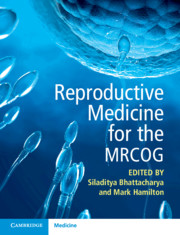Book contents
- Reproductive Medicine for the MRCOG
- Reproductive Medicine for the MRCOG
- Copyright page
- Contents
- Contributors
- Chapter 1 Epidemiology and Initial Assessment of the Infertile Patient
- Chapter 2 Disorders of Ovulation and Reproductive Endocrine Disorders Associated with Infertility
- Chapter 3 Endometriosis
- Chapter 4 Uterine and Tubal Causes of Infertility
- Chapter 5 Andrology and Infertility
- Chapter 6 Unexplained Infertility
- Chapter 7 Assisted Reproduction
- Chapter 8 Adjuvants in Assisted Reproduction
- Chapter 9 Laboratory Procedures for Assisted Reproduction
- Chapter 10 Fertility Preservation
- Chapter 11 Third-Party Reproduction
- Chapter 12 Managing Ethical Dilemmas in Reproductive Medicine
- Chapter 13 Evidence-Based Reproductive Medicine
- Chapter 14 The Organisation of Services and Quality Assurance in Fertility Practice
- Index
- References
Chapter 6 - Unexplained Infertility
Published online by Cambridge University Press: 25 February 2021
- Reproductive Medicine for the MRCOG
- Reproductive Medicine for the MRCOG
- Copyright page
- Contents
- Contributors
- Chapter 1 Epidemiology and Initial Assessment of the Infertile Patient
- Chapter 2 Disorders of Ovulation and Reproductive Endocrine Disorders Associated with Infertility
- Chapter 3 Endometriosis
- Chapter 4 Uterine and Tubal Causes of Infertility
- Chapter 5 Andrology and Infertility
- Chapter 6 Unexplained Infertility
- Chapter 7 Assisted Reproduction
- Chapter 8 Adjuvants in Assisted Reproduction
- Chapter 9 Laboratory Procedures for Assisted Reproduction
- Chapter 10 Fertility Preservation
- Chapter 11 Third-Party Reproduction
- Chapter 12 Managing Ethical Dilemmas in Reproductive Medicine
- Chapter 13 Evidence-Based Reproductive Medicine
- Chapter 14 The Organisation of Services and Quality Assurance in Fertility Practice
- Index
- References
Summary
Unexplained infertility refers to the inability to conceive within 12 months of unprotected intercourse, not attributable to any known causes of infertility such as ovulatory dysfunction, reduced sperm quality, tubal pathology or other causes. Treatment for unexplained infertility can be done predominantly through intrauterine insemination with or without hyperstimulation or in vitro fertilisation. Given that these treatments are utilised to improve likelihood of conception in relation to the couple’s chances of spontaneous pregnancy, rather than targeting any specific pathology, a comparison should be drawn between these treatments and their natural conception prognosis. Utilisation of prognostic models can allow differentiation between those likely to benefit from immediate treatment from such individuals who have reasonable natural conception prognosis and thereby can delay treatment for 6 months in hopes of spontaneous pregnancy. This comparison is valuable given the aforementioned treatments have implications for both the woman and her future child, and the cost of such procedures also compromises care accessibility.
Keywords
- Type
- Chapter
- Information
- Reproductive Medicine for the MRCOG , pp. 54 - 67Publisher: Cambridge University PressPrint publication year: 2021

